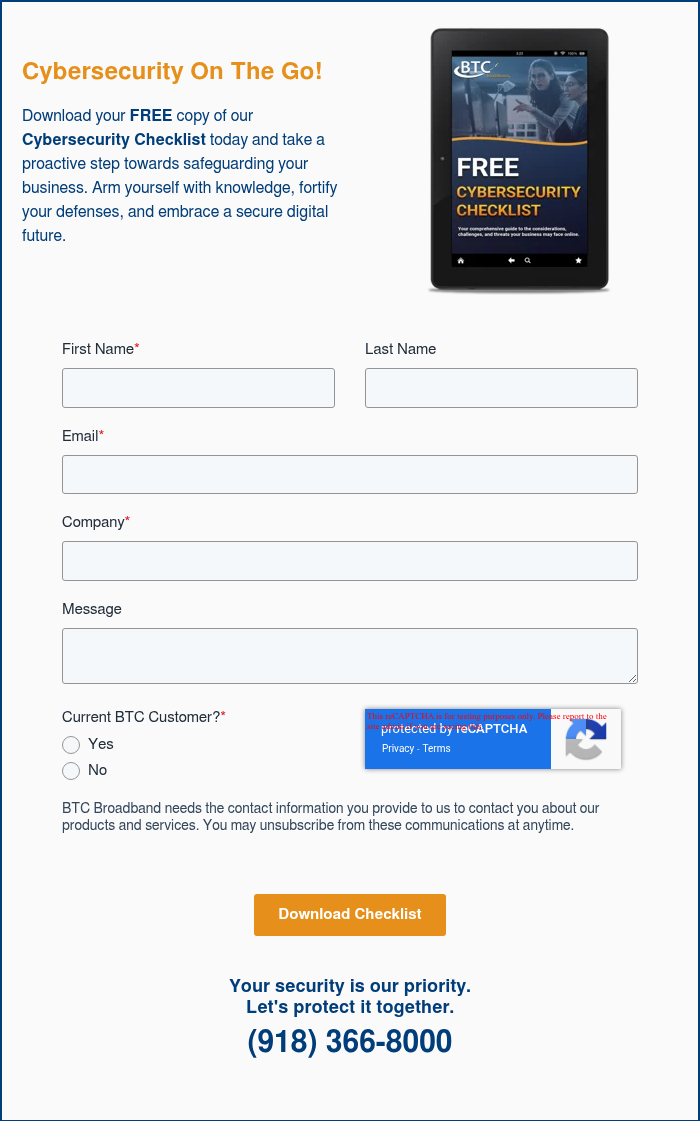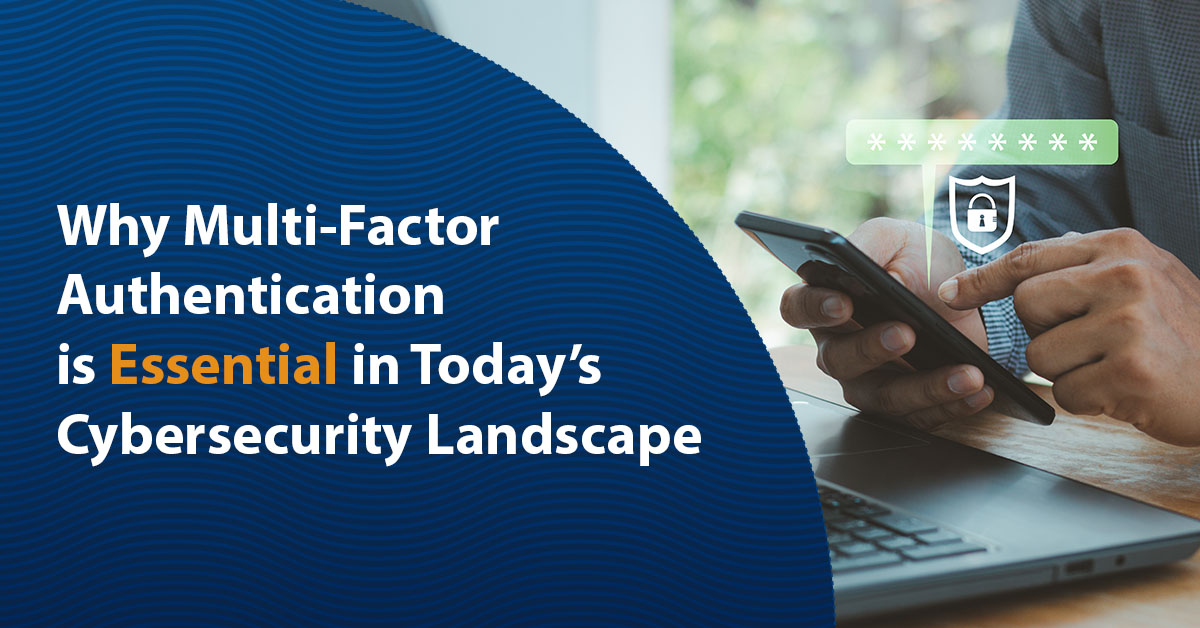BTC Broadband’s Guide to Cybersecurity

What is Cybersecurity?
Cybersecurity involves the crucial practice of safeguarding systems, networks, and programs from digital attacks. These attacks are often launched to illegally access, modify, or destroy sensitive information, extort money from users, or disrupt normal business processes.
In today’s world, where everything from work to shopping is online, cybersecurity has become a key player in keeping our digital lives safe.

The History of Cybersecurity
The origins of cybersecurity date back to the 1970s, when the first computer viruses were created, and the need for network security became apparent. As technology advanced, so did the complexity and frequency of threats, leading to the development of the cybersecurity industry.
The Evolving Threats Over the Years
Cyber threats have evolved dramatically from the Morris Worm in 1988 to sophisticated ransomware attacks in the current era. The threats have grown from simple viruses to complex malware, targeted cyber-espionage campaigns, and now newer strategies using AI technology.
The Cybersecurity Arms Race
The battle between cybercriminals and cybersecurity experts is ongoing. As new security measures develop, hackers find new ways to bypass them, leading to a constant need for more advanced security solutions.
Cybersecurity is More Important Than Ever
In today’s digital world, our reliance on technology has never been greater. Increased remote work, online transactions, and digital data storage have made cybersecurity essential for protecting personal, corporate, and national security.

What Types of Threats Are Out There?
Phishing
Phishing attacks are a form of cybercrime that uses fraudulent emails, messages, or websites to deceive individuals into divulging sensitive information, such as their login credentials or financial data.
These attacks are often designed to look like legitimate communications from trustworthy sources, but they are malicious attempts to steal personal information. Attackers can steal identities, commit financial fraud, or gain illegitimate access to sensitive systems and data.
Ransomware
Ransomware is a form of malware that prevents users from accessing their files. It encrypts files on the user’s system and demands payment for decryption. Ransomware can be spread in many ways, including email attachments, phishing scams, and malicious downloads.
Once a user’s files have been encrypted, the only way to regain access is to pay the ransom, often demanded in cryptocurrency like Bitcoin. Paying the ransom does not guarantee that the attacker will provide the decryption key, resulting in the loss of both data and money.
Insider Threats
Insider threats are a serious but often overlooked concern for organizations. They involve individuals who use their position and knowledge to exploit or compromise the organization’s security. These individuals can be employees, contractors, or partners who know the organization’s systems and processes.
Insider threats may occur intentionally or unintentionally, but they can cause significant damage to the organization’s reputation, financial standing, and overall security posture. Therefore, organizations need to have measures in place to ensure the safety of their assets and data.
DDoS Attacks
(Distributed Denial of Service)
DDoS (Distributed Denial of Service) attacks are digital attacks that involve flooding a system, service, or network with an enormous amount of traffic from multiple sources. This flood of traffic causes overwhelming requests to be sent to the targeted system, leading to its temporary or even permanent unavailability.
The goal of a DDoS attack is to obstruct the normal functioning of the targeted service, causing inconvenience to the user and financial loss to the organization.
Malware
Malware refers to harmful software specifically designed to exploit or damage computer systems. This includes viruses that can spread and infect other files, worms that can replicate themselves and spread across networks, and trojans that can disguise themselves as legitimate software while causing harm to the system they infect.
These types of software can cause significant damage to computer systems and expose sensitive data to unauthorized access.
Credential Stuffing
Credential stuffing is a method where hackers use many stolen usernames and passwords to gain unauthorized access to user accounts on different platforms or services. This attack works by exploiting the fact that many people reuse the same login credentials repeatedly on multiple sites, making it easier for the attackers to access their other accounts.
The attackers use automated tools to test these stolen credentials on various websites until they find a match, giving them access to the victim’s account. This practice seriously threatens online security and can lead to severe financial loss and identity theft.
The Pillars of Cybersecurity
Protection is essential in cybersecurity. It is your digital assets’ first defense against unauthorized access and potential threats. It focuses on implementing strong security measures to prevent cyberattacks proactively.
Effective strategies involve:
- Using robust passwords.
- Enabling two-factor authentication.
- Consistently updating software and systems to guard against known vulnerabilities.
Additionally, education about phishing scams and the promotion of secure browsing habits are crucial protection aspects.
By strengthening your digital defenses, you can reduce the risk of falling victim to cyber vulnerabilities and safeguard your valuable information and critical infrastructure from malicious individuals.
Detection plays a pivotal role in the cybersecurity triad by continuously monitoring systems and networks for signs of unauthorized activity or breaches.
The right tools and processes are critical to quickly identifying anomalies that could indicate a cybersecurity threat.
The goal is to detect potential threats as early as possible, minimizing the window of opportunity for attackers to inflict damage. Consistent security audits and vulnerability assessments are also critical best practices, helping organizations identify and address weaknesses before they can be exploited.
When a breach occurs, the response dictates how organizations react to mitigate the impact and recover from the attack.
Critical components of an effective response strategy include:
- Quickly isolate affected systems to prevent further damage.
- Eradicating the threat.
- Conducting a thorough investigation to understand how the breach occurred.
- Communicating transparently with stakeholders about the incident.
Recovery efforts also play a crucial part, focusing on restoring compromised data and systems to their normal states. Additionally, lessons learned from the incident are applied to strengthen future security measures and response plans, ensuring that each attack makes the organization more resilient against future threats.
Important Cybersecurity Considerations
In the digital landscape, where threats lurk in the shadows of every click and keystroke, establishing a comprehensive cybersecurity posture is necessary and a cornerstone of modern business practice.

Password Hygiene
Password hygiene refers to the practices that ensure passwords are strong, secure, and resistant to standard attack methods. Good password hygiene involves creating complex passwords, regularly updating them, and ensuring they are unique across different accounts and services.

Network Security
Network security involves policies, processes, and technologies that prevent unauthorized access, misuse, modification, or denial of network resources in response to cyber threats.

Data Protection
Data protection involves implementing measures and technologies to safeguard data from unauthorized access, corruption, or theft throughout its lifecycle. It includes a range of tasks, from securing data against cyber threats to ensuring compliance with various regulatory requirements.

Endpoint Security
Endpoint security refers to securing the entry points of end-user devices, including desktops, laptops, and mobile devices, to prevent bad actors from targeting them.
Secure Your Digital Future with BTC Tech Protect®.

Safeguarding your digital landscape is paramount in an era of constantly evolving cyber threats. BTC Tech Protect® is your steadfast ally, offering a comprehensive suite of features to fortify your cybersecurity posture and ensure business continuity.
24-hour Monitoring
Continuous surveillance of your systems to promptly identify and respond to threats, ensuring your operations remain secure around the clock.
Advanced Security
State-of-the-art protection mechanisms are tailored to guard against the latest cyber threats, keeping your digital assets safe.
Network Management
Expert oversight of your network infrastructure, ensuring optimal performance, security, and reliability of your digital operations.
Preventative Maintenance
Routine checks and maintenance are essential to identify and address potential issues before they intensify, maintaining the stability and integrity of your systems.
Server Virtualization
Efficient server management solutions that reduce costs, enhance data recovery capabilities, and streamline operations.
Backup as a Service (BaaS)
Reliable and secure data backup solutions ensure your important data is protected and can be quickly restored in case of loss or corruption.
End-to-End Support
Comprehensive support covers all IT infrastructure aspects, from setup and maintenance to troubleshooting and optimization.
System Administration
Professional management of your IT systems, ensuring they are always updated, secure, and aligned with your business needs.
Database Management
Expert handling of your database systems to ensure data accuracy, security, and optimal performance, supporting your decision-making processes.

Embrace the future with confidence,
knowing that BTC Tech Protect® is here to secure your digital journey every step of the way. Contact us today to embark on a path to enhanced cybersecurity, operational excellence, and uninterrupted growth.





